Environmental Risk Assessment for PM2.5 Pollution from Non-Point Sources in the Mining Area Based on Multi-Source Superposition and Diffusion
Abstract
1. Introduction
2. Methodology
2.1. The Research Area
2.2. Compilation of Particulate Matter Emission Inventory
2.3. Model
2.3.1. Model Setup and Simulation
2.3.2. Verification of Simulation
2.4. Analysis of Dust Particle Distribution and Spatial Transport Laws from Pollution Sources in Multi-Scale Mining Areas
2.5. Air Pollution Risk Assessment and Management
3. Results and Discussion
3.1. PM2.5 Emission Inventory Calculation and Spatial Distribution
3.2. PM2.5 Concentration Distribution Simulation
3.3. Concentration Contribution of Pollution Sources and Analysis of PM2.5 Spatial Distribution Law
3.3.1. Concentration Contribution of Single Pollution Sources
3.3.2. Relative Pollution Risk after the Multi-Source Superposition
3.3.3. Spatial Transport Law of Dust Particles in Multi-Scale Mining Areas
3.4. Air Pollution Risk Assessment and Management
3.5. Significance and Limitations
4. Conclusions
Supplementary Materials
Author Contributions
Funding
Institutional Review Board Statement
Informed Consent Statement
Data Availability Statement
Conflicts of Interest
References
- Gao, J.; Zhang, Y.C.; Wang, S.L.; Chai, F.H.; Chen, Y.Z. Study on the characteristics and formation of a multi-day haze in October 2011 in Beijing. Res. Environ. Sci. 2012, 25, 1201–1207. [Google Scholar] [CrossRef]
- Chen, Y.B.; Xu, J.; He, Y.J.; Du, X.H.; Tang, W.; Meng, F. Model analytic research of typical heavy PM2.5 pollution periods in winter in Beijing. Res. Environ. Sci. 2016, 29, 627–636. [Google Scholar] [CrossRef]
- Gautam, S.; Patra, A.K.; Sahu, S.P.; Hitch, M. Particulate matter pollution in opencast coal mining areas: A threat to human health and environment. Int. J. Min. Reclam. Environ. 2016, 32, 75–92. [Google Scholar] [CrossRef]
- Pokorná, P.; Hovorka, J.; Brejcha, J. Impact of Mining Activities on the Air Quality in the Village nearby a Coal Strip Mine. Iop Conf. Ser. Earth Environ. Sci. 2016, 44. [Google Scholar] [CrossRef]
- Soltani, N.; Keshavarzi, B.; Moore, F.; Cave, M.; Sorooshian, A.; Mahmoudi, M.R.; Ahmadi, M.R.; Golshani, R. In vitro bioaccessibility, phase partitioning, and health risk of potentially toxic elements in dust of an iron mining and industrial complex. Ecotoxicol. Environ. Saf. 2021, 212, 111972. [Google Scholar] [CrossRef]
- Patra, A.K.; Gautam, S.; Kumar, P. Emissions and human health impact of particulate matter from surface mining operation—A review. Environ. Technol. Innov. 2016, 5, 233–249. [Google Scholar] [CrossRef]
- Zhou, W.; Liu, H.; Xiang, J.; Zheng, J.; Yao, R.; Liu, S.; Liu, T.; Zhang, J.; Zhan, C.; Xiao, W.; et al. Assessment of Elemental Components in Atmospheric Particulate Matter from a Typical Mining City, Central China: Size Distribution, Source Characterization and Health Risk. Bull. Environ. Contam. Toxicol. 2020, 105, 941–950. [Google Scholar] [CrossRef]
- Zhang, W.; Wang, P.; Zhu, Y.; Wang, D.; Yang, R.; Li, Y.; Matsiko, J.; Zuo, P.; Qin, L.; Yang, X.; et al. Occurrence and human exposure assessment of organophosphate esters in atmospheric PM2.5 in the Beijing-Tianjin-Hebei region, China. Ecotoxicol. Environ. Saf. 2020, 206, 111399. [Google Scholar] [CrossRef] [PubMed]
- Khamraev, K.; Cheriyan, D.; Choi, J.-H. A review on health risk assessment of PM in the construction industry Current situation and future directions. Sci. Total Environ. 2021, 758. [Google Scholar] [CrossRef]
- Zhi, M.; Zhang, X.; Zhang, K.; Ussher, S.J.; Lv, W.; Li, J.; Gao, J.; Luo, Y.; Meng, F. The characteristics of atmospheric particles and metal elements during winter in Beijing: Size distribution, source analysis, and environmental risk assessment. Ecotoxicol. Environ. Saf. 2021, 211, 111937. [Google Scholar] [CrossRef]
- Guo, J.; Zhuang, T.; Liu, S.J.; Huang, X.J. Numerical Simulation Study on the Effect of Fugitive Emissions of Particulate Matter on Air Quality in Industrial Area. Environ. Sci. Technol. 2018, 31, 56–61. [Google Scholar]
- Huertas, J.I.; Huertas, M.E.; Izquierdo, S.; Gonzalez, E.D. Air quality impact assessment of multiple open pit coal mines in northern Colombia. J. Env. Manag. 2012, 93, 121–129. [Google Scholar] [CrossRef] [PubMed]
- Arregocés, H.; Rojano, R.; Restrepo, G.; Angulo, L. Using CALPUFF to Determine the Environmental Impact of a Coal Mine Open Pit. In Proceedings of the Air Pollution Xxiv, 24th International Conference on Modelling, Monitoring and Management of Air Pollution, Crete, Greece, 20–22 June 2016; Longhurst, J.W.S., Brebbia, C.A., Barnes, J., Eds.; WIT Transactions on Ecology and the Environment. Wit Press: Southampton, UK, 2016; Volume 207, pp. 55–66. [Google Scholar] [CrossRef]
- Huertas, J.I.; Camacho, D.A.; Huertas, M.E. Standardized emissions inventory methodology for open-pit mining areas. Environ. Sci. Pollut. Res. Int. 2011, 19, 2784–2794. [Google Scholar] [CrossRef] [PubMed]
- Huertas, J.I.; Huertas, M.E.; Cervantes, G.; Diaz, J. Assessment of the natural sources of particulate matter on the opencast mines air quality. Sci. Total Environ. 2014, 493, 1047–1055. [Google Scholar] [CrossRef]
- Chakraborty, M.K.; Ahmad, M.; Singh, R.S.; Pal, D.; Bandopadhyay, C.; Chaulya, S.K. Determination of the emission rate from various opencast mining operations. Environ. Model. Softw. 2002, 17, 467–480. [Google Scholar] [CrossRef]
- Richardson, C.; Rutherford, S.; Agranovski, I. Particulate emission rates for open surfaces in Australian open cut black coal mines. J. Environ. Manag. 2019, 232, 537–544. [Google Scholar] [CrossRef]
- Zhang, X.; Chen, W.; Ma, C.; Zhan, S. Modeling particulate matter emissions during mineral loading process under weak wind simulation. Sci. Total Environ. 2013, 449, 168–173. [Google Scholar] [CrossRef]
- Li, S.W.; Li, W.S.; Lei, P.; Peng, S.T. Research on dust emission of iron ore for bulk-cargo yard of ore terminal by using wind tunnel test. J. Waterw. Harb. 2016, 37, 558–562. [Google Scholar]
- Huertas, J.I.; Huertas, M.E.; Díaz, J. Assessing precision and accuracy of atmospheric emission inventories. Int. J. Environ. Sci. Technol. 2012, 9, 195–202. [Google Scholar] [CrossRef][Green Version]
- Huang, C.; Li, S.J. Contrast of two calculation methods of wind erosion dust sources in coal storage yard. China Harb. Eng. 2015, 35, 48–52. [Google Scholar] [CrossRef]
- Romeo, A.; Capelli, L.; Sironi, S.; Nano, G.; Rota, R.; Busini, V. Dust emission and dispersion from mineral storage piles. Environ. Sci. Pollut. Res. 2017, 24, 22663–22672. [Google Scholar] [CrossRef] [PubMed]
- Cui, K.Q.; Wang, X.Z.; He, Y.J.; Meng, F. Surface mine dump dust emissions and pollution in Xilinhot[J]. J. Arid Land Resour. Environ. 2017, 31, 160–165. [Google Scholar] [CrossRef]
- Ouyang, M.; Zhang, J.J.; Hu, S.M. Estimation of dust emission coefficient from mine transportation and storage yard and analysis of prevention and control measures. Pioneer. Sci. Technol. Mon. 2016, 29, 122–125. [Google Scholar] [CrossRef]
- Qin, J.X.; Zhu, K.Y.; Wu, T.; Shen, H.Q. Study on Spatial and Temporal Characteristics of Construction Dust and Soil Dust Pollution Sources in Urban Areas of Changsha. Environ. Monit. China 2020, 36, 69–79. [Google Scholar] [CrossRef]
- Asif, Z.; Chen, Z.; Han, Y. Air quality modeling for effective environmental management in the mining region. J. Air Waste Manag Assoc. 2018, 68, 1001–1014. [Google Scholar] [CrossRef]
- Holmes, N.S.; Morawska, L. A review of dispersion modelling and its application to the dispersion of particles: An overview of different dispersion models available. Atmos. Environ. 2006, 40, 5902–5928. [Google Scholar] [CrossRef]
- Rood, A.S. Performance evaluation of AERMOD, CALPUFF, and legacy air dispersion models using the Winter Validation Tracer Study dataset. Atmos. Environ. 2014, 89, 707–720. [Google Scholar] [CrossRef]
- Tartakovsky, D.; Broday, D.M.; Stern, E. Evaluation of AERMOD and CALPUFF for predicting ambient concentrations of total suspended particulate matter (TSP) emissions from a quarry in complex terrain. Environ. Pollut. 2013, 179, 138–145. [Google Scholar] [CrossRef]
- Lal, B.; Tripathy, S.S. Prediction of dust concentration in open cast coal mine using artificial neural network. Atmos. Pollut. Res. 2012, 3, 211–218. [Google Scholar] [CrossRef]
- Petavratzi, E.; Kingman, S.; Lowndes, I. Particulates from mining operations: A review of sources, effects and regulations. Miner. Eng. 2005, 18, 1183–1199. [Google Scholar] [CrossRef]
- Lei, P. Research on Dusting Rules for Bulk-Cargo Yard of Iron Ore and Coal Terminal. Master’s Thesis, Tianjin University, Tianjin, China, 2014. [Google Scholar]
- Zhou, Y.; Zhao, Y.; Mao, P.; Zhang, Q.; Zhang, J.; Qiu, L.; Yang, Y. Development of a high-resolution emission inventory and its evaluation and application through air quality modeling for Jiangsu Province, China. Atmos. Chem. Phys. 2017, 17, 211–233. [Google Scholar] [CrossRef]
- Liu, C.L.; Xie, F.J.; Zheng, X.M.; Wang, Y. Optimizations of Spatial Allocation of Air Pollutant Emission Inventory in Nanjing. J. Green Sci. Technol. 2019, 97–99. [Google Scholar] [CrossRef]
- Shen, Y.; Jiang, C.; Chan, K.L.; Hu, C.; Yao, L. Estimation of Field-Level NOx Emissions from Crop Residue Burning Using Remote Sensing Data: A Case Study in Hubei, China. Remote Sens. 2021, 13, 404. [Google Scholar] [CrossRef]
- Hadlocon, L.S.; Zhao, L.Y.; Bohrer, G.; Kenny, W.; Garrity, S.R.; Wang, J.; Wyslouzil, B.; Upadhyay, J. Modeling of particulate matter dispersion from a poultry facility using AERMOD. J. Air Waste Manag Assoc. 2015, 65, 206–217. [Google Scholar] [CrossRef]
- Chang, J.C.; Hanna, S.R. Air quality model performance evaluation. Meteorol. Atmos. Phys. 2004, 87, 167–196. [Google Scholar] [CrossRef]
- Rojano, R.; Arregocés, H.; Angulo, L.; Restrepo, G. PM10 emissions due to storage in coal piles in a mining industrial area. In Proceedings of the Air Pollution Xxiv, 24th International Conference on Modelling, Monitoring and Management of Air Pollution, Crete, Greece, 20–22 June 2016; Longhurst, J.W.S., Brebbia, C.A., Barnes, J., Eds.; WIT Transactions on Ecology and the Environment. WIT Press: Santiago de Compostella, Spain; Volume 207, pp. 87–97. [Google Scholar] [CrossRef]
- Arregoces, H.A.; Rojano, R.E.; Ângulo, L.C.; Restrepo, G.M. Predicción y Análisis de la Contribución de PM10 desde Pilas de Carbón en una Mina a Cielo Abierto. Inf. Technol. 2016, 27, 93–102. [Google Scholar] [CrossRef][Green Version]
- Ghannam, K.; El-Fadel, M. A framework for emissions source apportionment in industrial areas: MM5/CALPUFF in a near-field application. J. Air Waste Manag Assoc. 2013, 63, 190–204. [Google Scholar] [CrossRef]
- Diego, I.; Pelegry, A.; Torno, S.; Toraño, J.; Menendez, M. Simultaneous CFD evaluation of wind flow and dust emission in open storage piles. Appl. Math. Model. 2009, 33, 3197–3207. [Google Scholar] [CrossRef]
- Hilton, J.E.; Cleary, P.W. Dust modelling using a combined CFD and discrete element formulation. Int. J. Numer. Methods Fluids 2013, 72, 528–549. [Google Scholar] [CrossRef]
- Zhu, J.; Zhu, J.; Lin, H.; Lin, W.S.; Xu, B.L. Study on Virtual Geographic Environment for Simulation of Air Pollution Dispersion. J. Syst. Simul. 2008, 20, 176–179, 186. [Google Scholar]
- Hong, Y.F.; Liu, F.; Dou, Y.S.; Shen, S.L.; Hu, G.H. Application of Gaussian superposition model to multi-source pollution in regional atmospheric environmental impact assessment. Chongqing Environ. Sci. 1996, 18, 9–13. [Google Scholar]
- Ping, C. Application of Atmospheric Pollutant Long-Term Diffusion Model. Master’s Thesis, Tianjin University, Tianjin, China, 2006. [Google Scholar]
- He, G.X.; Feng, H.; Zhang, H.R. Diffusion and attenuation models of PM2.5 in the atmosphere. Math. Pract. Theory 2014, 44, 28–36. [Google Scholar]
- Wade, D.; Senocak, I. Stochastic reconstruction of multiple source atmospheric contaminant dispersion events. Atmos. Environ. 2013, 74, 45–51. [Google Scholar] [CrossRef]
- Duijm, N.J. Dispersion over complex terrain: Wind-tunnel modelling and analysis techniques. Atmos. Environ. 1996, 30, 2839–2852. [Google Scholar] [CrossRef]
- Sorte, S.; Arunachalam, S.; Naess, B.; Seppanen, C.; Rodrigues, V.; Valencia, A.; Borrego, C.; Monteiro, A. Assessment of source contribution to air quality in an urban area close to a harbor: Case-study in Porto, Portugal. Sci. Total Environ. 2019, 662, 347–360. [Google Scholar] [CrossRef]
- Liu, F.; Jia, W.L. Computer simulation of multi-source atmospheric diffusion. Environ. Prot. Oil Gas. Fields 1993, 3, 21–24. [Google Scholar]
- Liu, L. Identifying Regional Atmospheric Risks of Industrial Park Planning: Methodology and Case Study. Master’s Thesis, Tsinghua University, Beijing, China, 2014. [Google Scholar]
- Wambebe, N.M.; Duan, X. Air Quality Levels and Health Risk Assessment of Particulate Matters in Abuja Municipal Area, Nigeria. Atmosphere 2020, 11, 817. [Google Scholar] [CrossRef]
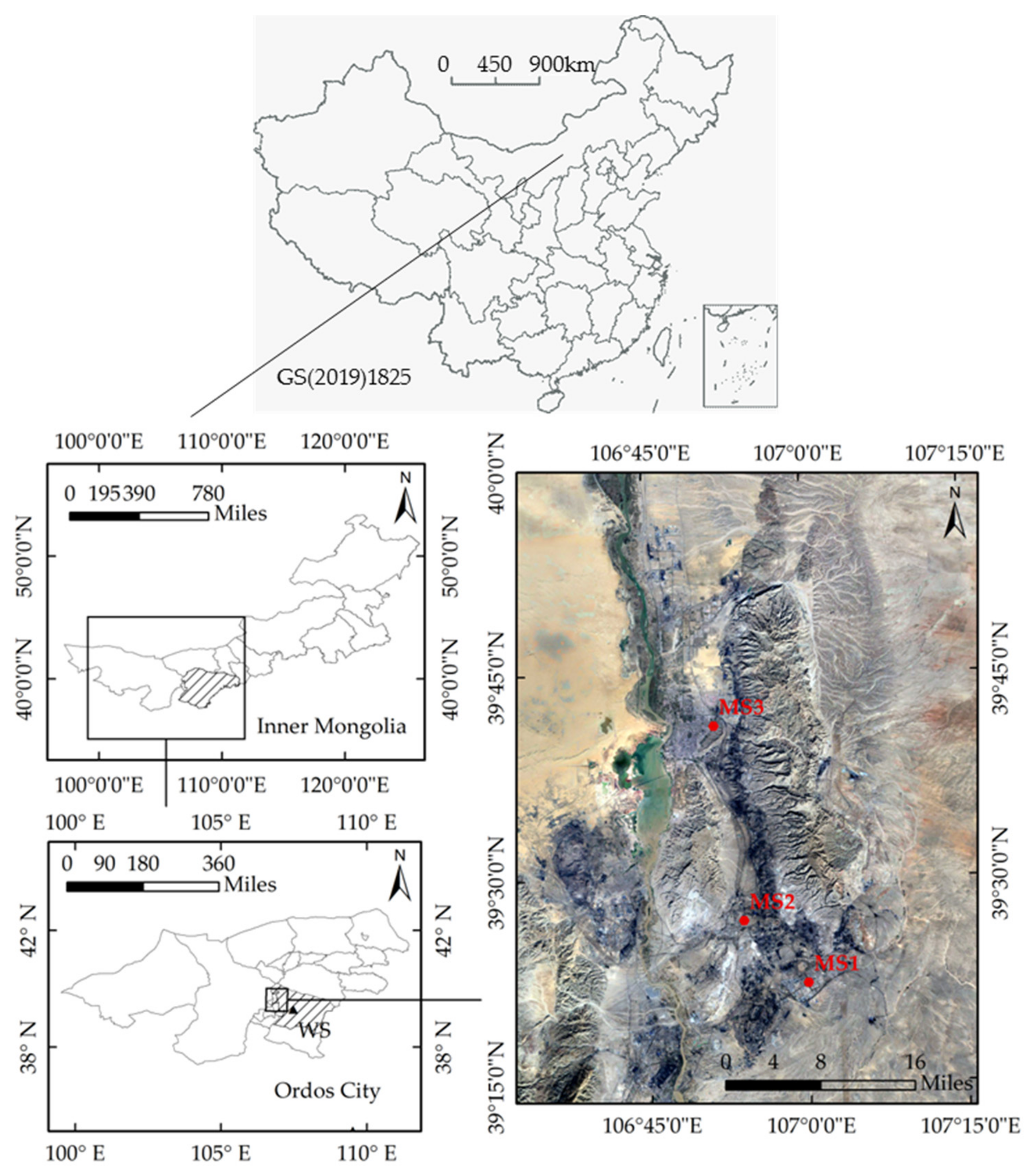
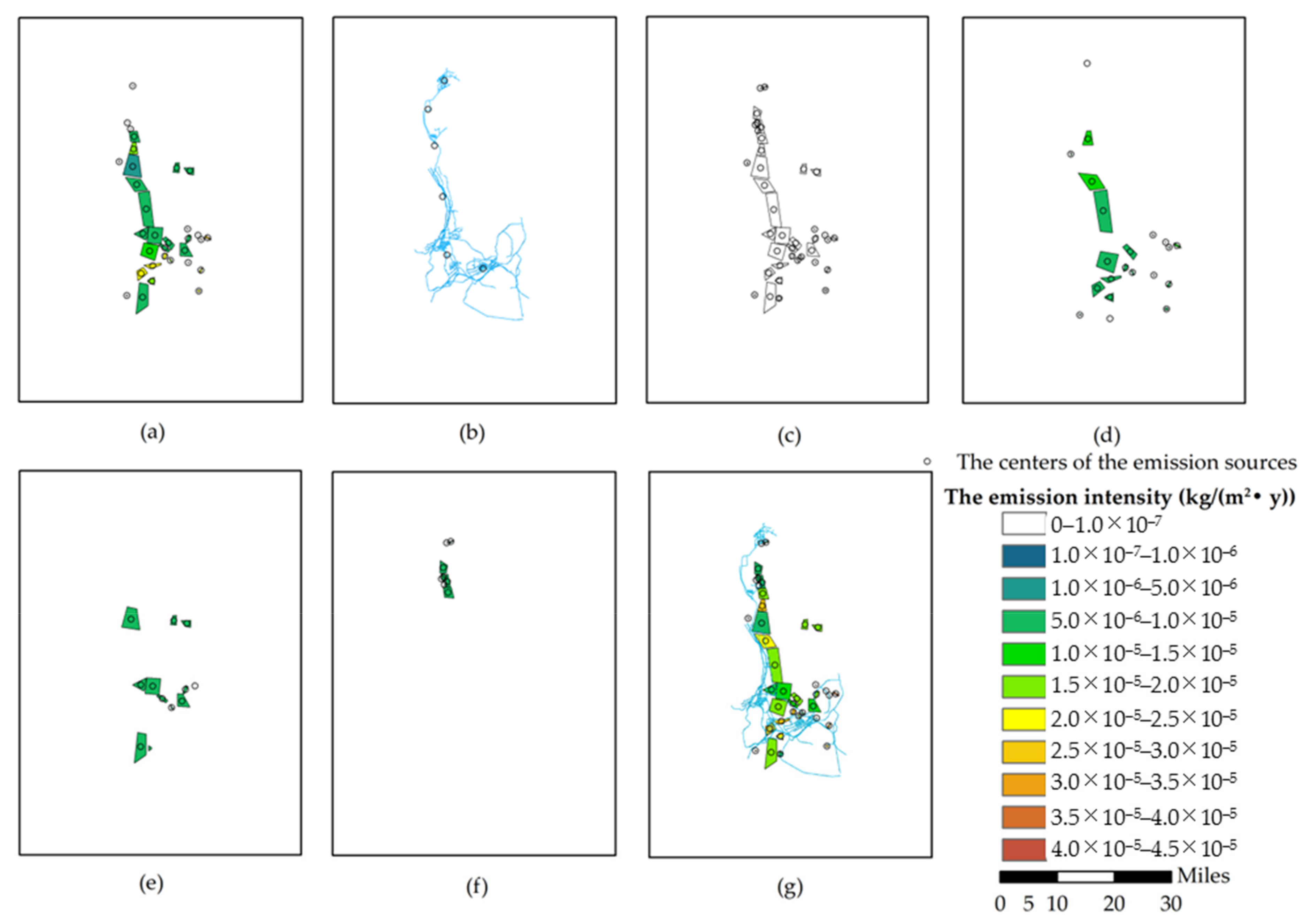
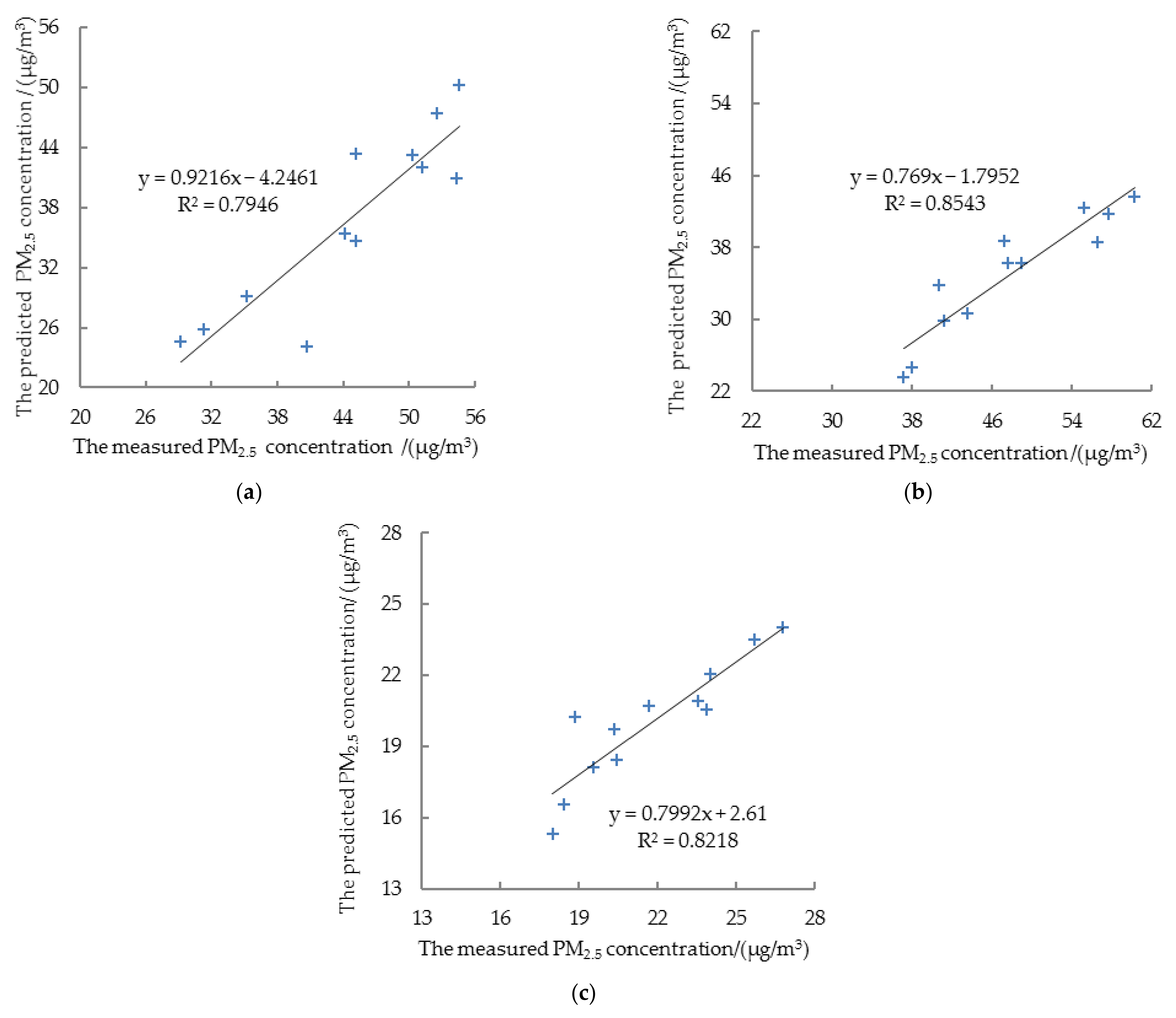
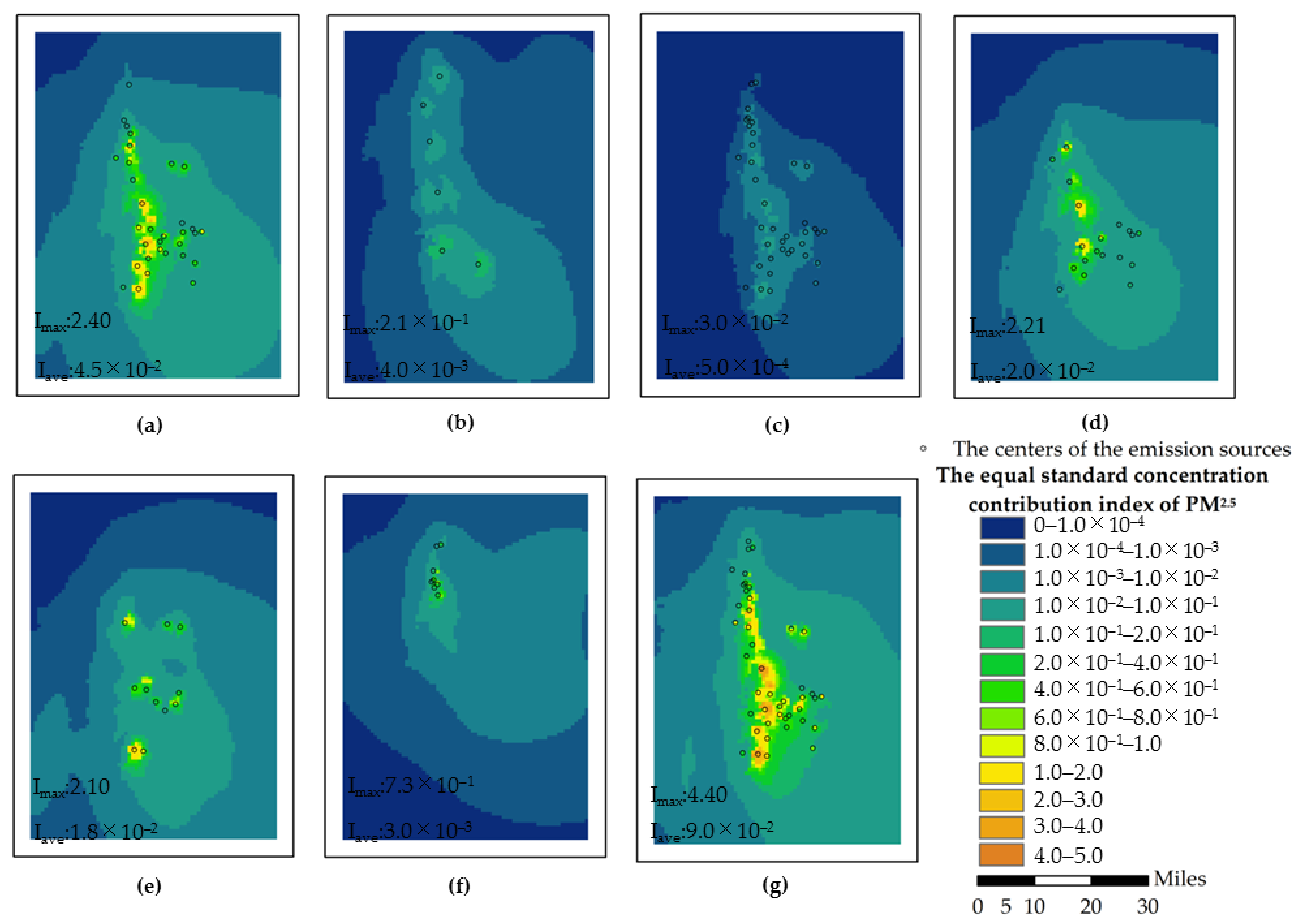

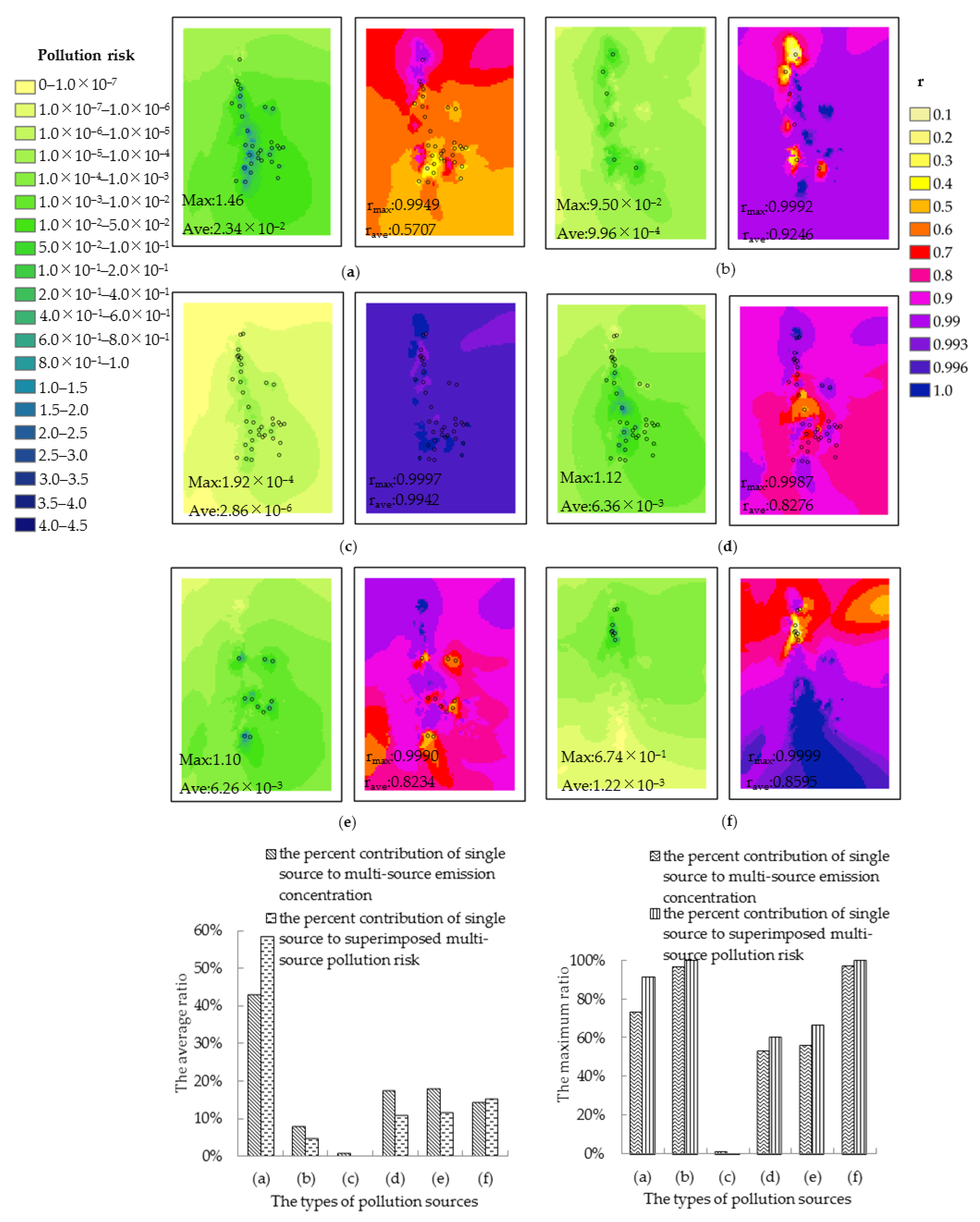
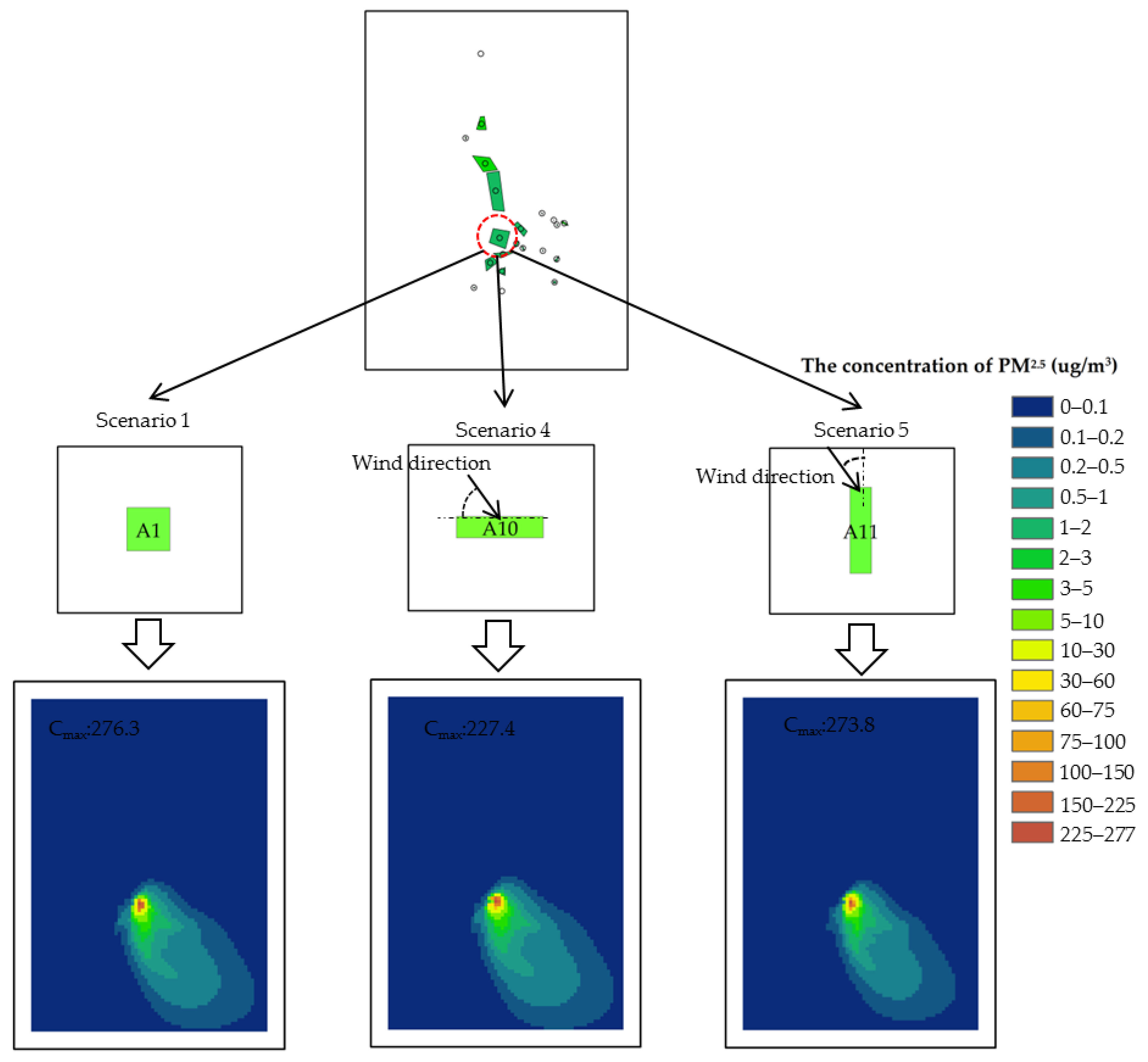
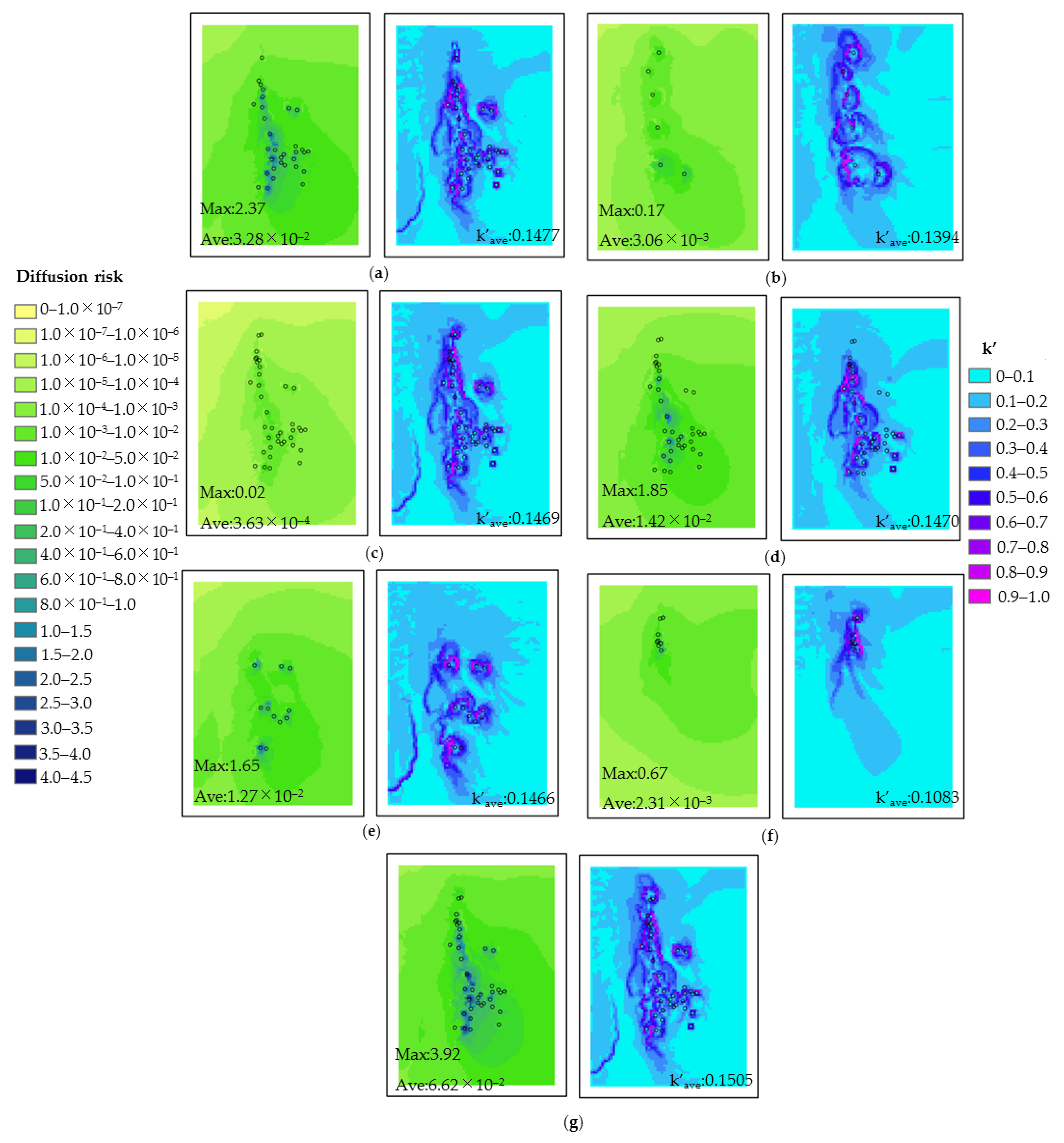
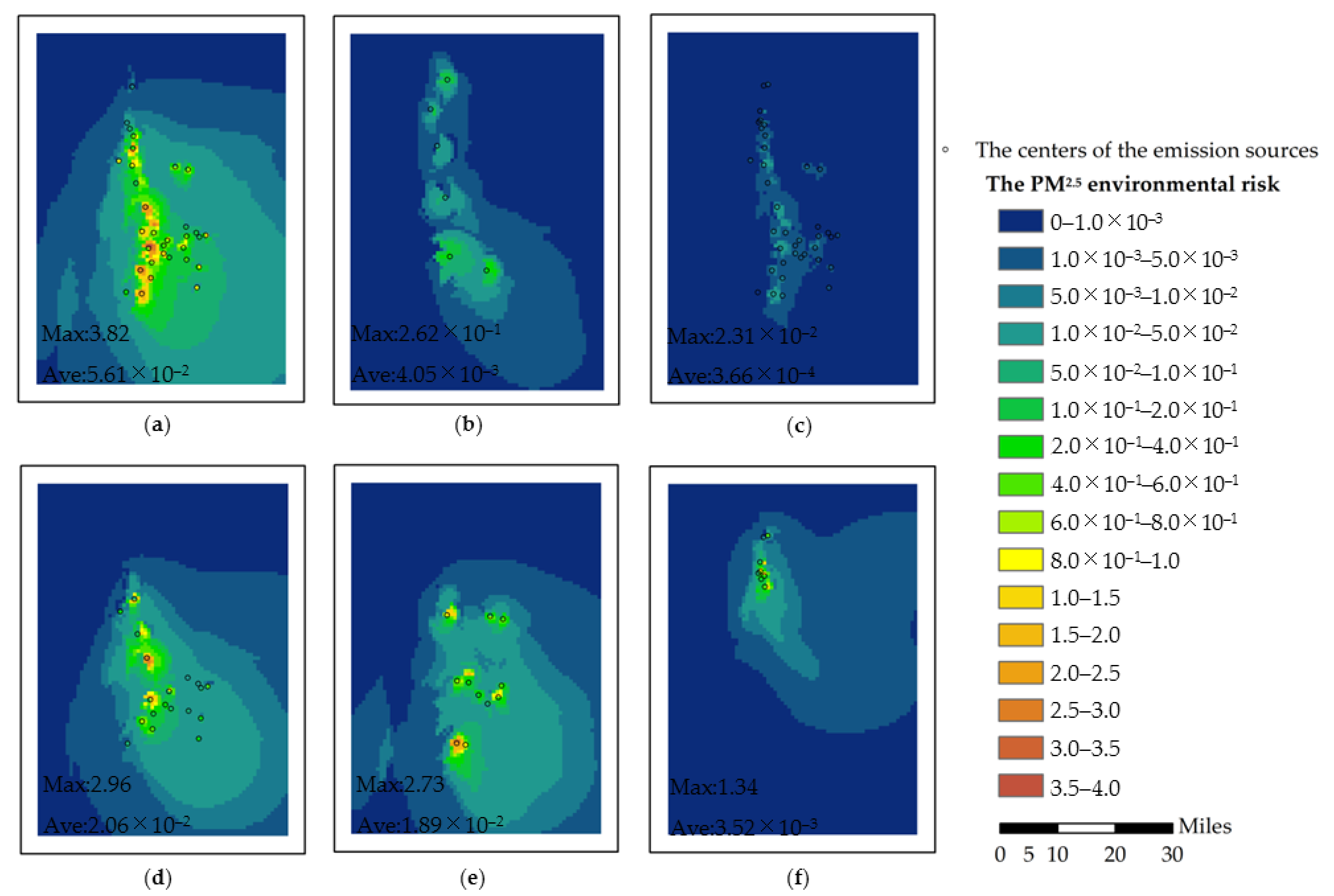

| Source Type Generalization | Secondary Classification of Emission Sources | Emission Source Statistics [6,14,16,30,31] |
|---|---|---|
| Road transport dust sources | Paved road | Overburden transport, surface soil transport, coal transport, material transport |
| Non-paved road | Overburden transport, surface soil transport, coal transport, material transport | |
| Exposed surface dust sources | Coal piles | Wind erosion on the surface of the coal piles |
| Mine pits and dumps | Wind erosion on the surface of the dumps and mine pits | |
| Quarries | Wind erosion on the exposed surface of stone piles and stone mining sites | |
| Material loading and unloading dust sources | Loading and unloading | Coal loading and unloading, topsoil removal, bulldozing, topsoil loading and Unloading, drilling and blasting operation, coal mining, stone loading and unloading, material transfer, coal processing workshop |
| Monitoring Point | Position Coordinates | Monitoring Period |
|---|---|---|
| MS1 | 672,281.2 E, 4,359,904.6 N | 8 January, 10 February, 21 March, 21 April, 14 May, 13 June, 22 July, 26 August, 13 September, 21 October, 18 November, 18 December (12 days in total) |
| MS2 | 663,517.4 E, 4,368,254.7 N | |
| MS3 | 659,339.3 E, 4,394,614.5 N |
| Index | Formula | Criterion [20,36] | Optimum Value [28] | Number |
|---|---|---|---|---|
| FB (fractional bias) | ∣FB∣ < 0.5 | 0 | (3) | |
| MG (geometric mean bias) | 0.75–1.3 | 1 | (4) | |
| VG (geometric variance) | 1–1.3 | 1 | (5) | |
| R2(coefficient of determination) | >0.8 | 1 | (6) | |
| NMSE (normalized mean square error) | <0.5 | 0 | (7) | |
| FAC2 (fraction of two) | The ratio of CP/CO data 1 in the interval of (0.5, 2) | >0.5 | 1 | (8) |
| Number | Formula/Parameter | Significance |
|---|---|---|
| (9) | Equal contribution index of standard concentration of pollutant source i at the location j | |
| Cij | The PM2.5 concentration contribution of single pollutant source i at the location j | |
| Cs | The standard concentration limit for PM2.5 | |
| i | The serial number of the pollution source | |
| n | Total number of pollution sources | |
| j | A place at some distance from the pollutant source | |
| (10) | The relative contribution ratio of superimposed sources for pollutant source i at the location j | |
| The PM2.5 concentration contribution of the multi-source superposition at the location j | ||
| (11) | The PM2.5 concentration at a location that is hx meters away from the center of the source i | |
| Ci0 | The PM2.5 concentration at the center of the source i | |
| (12) | The PM2.5 concentration change at the location that is h meters away from the center of the source i | |
| Cij | The PM2.5 concentration at the location that is h meters away from the center of the source i | |
| Cij-1 | The PM2.5 concentration at the location that is h-Δh meters away from the center of the source i | |
| (13) | The change rate of PM2.5 concentration emitted from the pollutant source i at the position j |
| Emission Source | Weight of the Dust (t/a) |
|---|---|
| Non-paved roads | 892.74 |
| Coal piles | 176.77 |
| Mine pits and dumps | 148.10 |
| Paved road | 132.69 |
| Quarries | 21.42 |
| Loading and unloading sources | 9.33 |
| Total (t/a) | 1381.05 |
| Station | MS1 | MS2 | MS3 |
|---|---|---|---|
| FB | 0.19 | 0.31 | 0.08 |
| MG | 1.22 | 1.29 | 1.09 |
| VG | 1.06 | 1.11 | 1.01 |
| NMSE | 0.05 | 0.10 | 0.01 |
| R2 | 0.79 | 0.85 | 0.82 |
| FVC2 (%) | 100.00 | 100.00 | 100.00 |
| Parameter | Period | |||||||
|---|---|---|---|---|---|---|---|---|
| 0:00 | 3:00 | 6:00 | 9:00 | 12:00 | 15:00 | 18:00 | 21:00 | |
| Wind direction | NNW | SW | WNW | NW | WNW | NW | N | WNW |
| Wind speed (m/s) | 1.1 | 2.3 | 3.7 | 3.0 | 3.8 | 3.2 | 1.9 | 1.1 |
| Risk Level | Classification Standard |
|---|---|
| Low | 0 < R ≤ 1.2 |
| Medium | 1.2 < R ≤ 4.0 |
| High | 4.0 < R ≤ 8.0 |
Publisher’s Note: MDPI stays neutral with regard to jurisdictional claims in published maps and institutional affiliations. |
© 2021 by the authors. Licensee MDPI, Basel, Switzerland. This article is an open access article distributed under the terms and conditions of the Creative Commons Attribution (CC BY) license (https://creativecommons.org/licenses/by/4.0/).
Share and Cite
Zhou, L.; Li, Z.; Meng, L.; Li, T.; Domingos Raimundo Lopes, N. Environmental Risk Assessment for PM2.5 Pollution from Non-Point Sources in the Mining Area Based on Multi-Source Superposition and Diffusion. Sustainability 2021, 13, 6619. https://doi.org/10.3390/su13126619
Zhou L, Li Z, Meng L, Li T, Domingos Raimundo Lopes N. Environmental Risk Assessment for PM2.5 Pollution from Non-Point Sources in the Mining Area Based on Multi-Source Superposition and Diffusion. Sustainability. 2021; 13(12):6619. https://doi.org/10.3390/su13126619
Chicago/Turabian StyleZhou, Liying, Zichen Li, Linglong Meng, Tianxin Li, and Namir Domingos Raimundo Lopes. 2021. "Environmental Risk Assessment for PM2.5 Pollution from Non-Point Sources in the Mining Area Based on Multi-Source Superposition and Diffusion" Sustainability 13, no. 12: 6619. https://doi.org/10.3390/su13126619
APA StyleZhou, L., Li, Z., Meng, L., Li, T., & Domingos Raimundo Lopes, N. (2021). Environmental Risk Assessment for PM2.5 Pollution from Non-Point Sources in the Mining Area Based on Multi-Source Superposition and Diffusion. Sustainability, 13(12), 6619. https://doi.org/10.3390/su13126619





